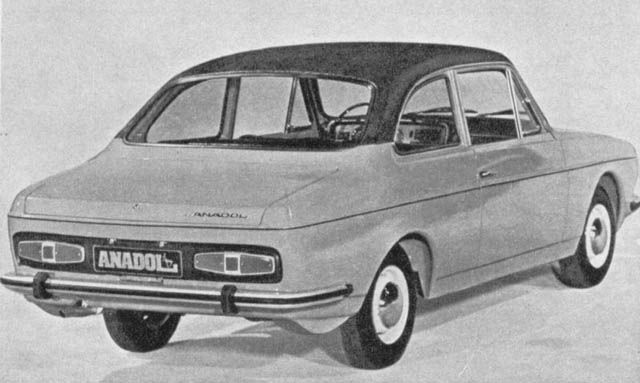The year 1974 marked a significant milestone in Turkish automotive history with the Anadol A2 rolling off Otosan’s production lines. This wasn’t just another car launch — it represented Turkey’s ambitious stride into domestic automobile manufacturing. The A2 emerged during a period when established European manufacturers dominated the market, yet it carved its own distinctive path.
Local manufacturing expertise combined with Ford’s proven technology created something unique in the automotive landscape. The A2 wasn’t trying to compete with luxury European offerings or American muscle cars. Instead, it addressed a specific need: providing Turkish drivers with a reliable, locally-produced vehicle that understood local conditions.
Engineering Marvel: Ford Heritage Meets Turkish Innovation
The heart of the A2 beats with Ford engineering — a front-mounted OHV four-cylinder engine delivering 54 PS of power. This powerplant, with its 8.0:1 compression ratio, balanced performance with reliability, achieving 0-60 mph in 18 seconds. While these numbers might seem modest today, they represented competitive performance for a family car in 1974.
Fact!
The Anadol A2's fiberglass body construction was revolutionary for its time in Turkey, making it one of the few mass-produced cars globally to use this material extensively.
“I’ve worked on numerous A2s over the years,” shares Mehmet Yılmaz, a vintage car specialist in Istanbul. “The Ford-derived engine is remarkably sturdy. With proper maintenance, these motors can easily clock 200,000 kilometers without major overhaul.”
The engineering team made clever adaptations to suit local conditions. The suspension system was reinforced to handle rough roads, while the cooling system was enhanced to cope with hot Turkish summers.
Design Evolution: Where East Meets West
The A2’s design represented a significant evolution from its predecessors. Its dimensions — 4440mm length, 1645mm width, and 1420mm height — created a presence that balanced aesthetics with practicality. The styling incorporated elements of 1970s automotive design while maintaining a distinct Turkish character.
The vehicle’s proportions followed contemporary European trends, but details like the grille design and taillight arrangement gave it a unique identity. Interior ergonomics reflected careful consideration of Turkish family needs, with emphasis on passenger comfort and practical storage solutions.
Key design features that set the A2 apart:
- distinctive wraparound front bumper design;
- integrated side impact protection;
- aerodynamic profile reducing fuel consumption;
- enlarged greenhouse improving visibility;
- reinforced roof structure enhancing safety.
The attention to detail extended to every aspect of the car’s design, creating a cohesive package that looked modern while remaining distinctively Anadol.
Historical Impact: Shaping an Industry
The A2’s influence extended far beyond its sales figures. It proved that Turkey could produce sophisticated consumer goods, inspiring confidence in domestic manufacturing capabilities.
Historical Reference!
The Anadol A2 was the first mass-produced passenger car to feature extensive use of fiberglass body panels in Turkey, setting a precedent for innovative manufacturing techniques in the region.
“The A2 wasn’t just a car — it was a statement of industrial capability,” notes Dr. Ahmet Kaya, automotive historian at Istanbul Technical University. “It demonstrated that Turkish engineering could adapt and improve upon international standards.”
This achievement laid the groundwork for Turkey’s current position as a significant automotive manufacturer. The lessons learned from the A2 program influenced future developments in Turkish automotive engineering.
Market Legacy: A Collector’s Perspective
Today, the Anadol A2 occupies a special place in the classic car market. Surviving examples, identifiable by VIN numbers like T0A2PS130552, command increasing attention from collectors. The car’s rarity — especially well-preserved examples — has contributed to steady value appreciation.
Important!
Original A2 parts are becoming increasingly scarce, making documented, complete vehicles particularly valuable to collectors and historians.
Restoration challenges have actually enhanced the car’s appeal among dedicated enthusiasts. Each restored A2 represents not just a vehicle, but a piece of preserved automotive history.
The market has seen several noteworthy examples:
- preserved original models with documented history;
- professionally restored vehicles maintaining period accuracy;
- modified versions showcasing Turkish customization culture;
- museum-quality specimens representing significant milestones.
These surviving A2s serve as rolling ambassadors of Turkish automotive heritage.
The Road Ahead
The Anadol A2’s story continues to resonate in today’s automotive landscape. Its blend of international technology with local adaptation remains relevant as emerging markets develop their automotive industries.
Looking beyond its historical significance, the A2 represents something more profound — the ability of a nation to transform its industrial capabilities through determination and innovation.
Pros and Cons
| Advantages | Limitations |
|---|---|
| Pioneer in Turkish automotive industry with historical significance | Limited performance by modern standards (0-60 mph in 18 seconds) |
| Durable Ford-derived powertrain with proven reliability | Scarcity of original replacement parts |
| Innovative fiberglass body construction reducing weight | Restoration requires specialized knowledge |
| Adapted specifically for Turkish market conditions | Limited production numbers affecting parts availability |
| Strong collector value potential | Challenging to find in original condition |
| Excellent documentation of production history | Requires careful maintenance of fiberglass body |
| Represents significant industrial heritage | Performance modifications limited by original design |
The Anadol A2 transcends its role as merely a classic car. It stands as a testament to Turkish industrial ambition and engineering capability. While it may not match contemporary performance standards, its historical significance and unique construction make it an increasingly valuable collector’s item. For enthusiasts of automotive history or Turkish industrial development, the A2 represents an important milestone worth preserving and celebrating.

